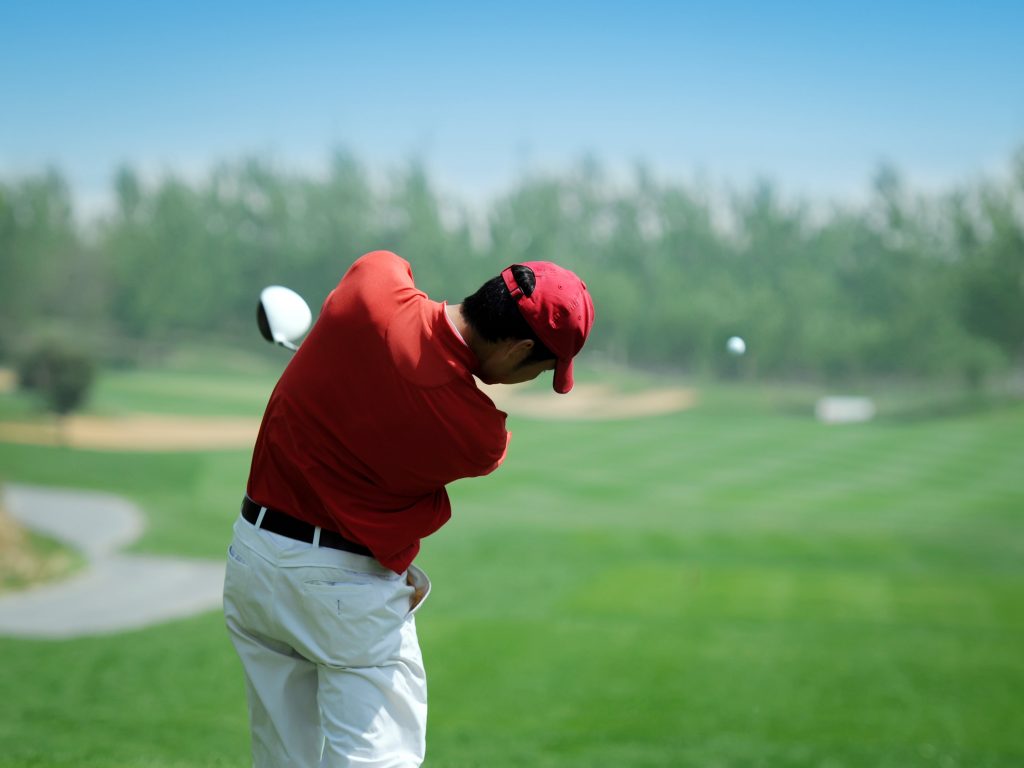Eighteen holes of golf will always throw up various different tests and situations. The ability to play different golf shot shapes—from tucked away pins to simply finding the middle of the green—is a huge benefit.
In this guide, we speak to PGA Pro Barney Puttick about some of the most common golf shot shapes and how best to play them.
We’ve broken it down into the four golf shot shapes you’re most likely to find on the course and how you can practise each one.
What are the most common golf shot shapes?

Table of contents
1. The Low Shot
2. The High Shot
3. The Fade
4. The Draw
1. The Low Shot

Barney says…
What I get my students to do is narrow their stance and then move the ball back towards the middle of the stance.
I think the best way to learn how to hit it ‘low’ is to get a 7 or 8-iron and start with 30-yard chip shots. That way, you’ll start to get the feeling of keeping your hands in front, but you’ll also be practising hip rotation to get the right synchronisation.
A common mistake golfers often make is they stick their hands just in front and then just prod them forward without any lower half movement. So, instead, try playing a chip and then expand it to 60-70 yards. The art for me, then, is truncating the swing on either side of the ball, so you go chest-high to chest-high, and because you have the slightly narrower stance and the ball positioned a bit further back, you can retain the angle through the impact zone. Then, you get that nice trapping sort of shot, and it takes off from there.
If you rehearse a few throwing movements, that will start to give you the synchronisation with the lower half. An underarm or side throw, similar to throwing a cricket ball or playing a forehand shot in tennis, for example, is good for understanding the feeling of movement in the hips.
2. The High Shot

Barney says…
Most golfers don’t struggle too much with getting the ball up as their angle of attack is quite steep. Here, it’s all about moving the ball further forward in the stance—normally, with a 6-iron, you’d be halfway between the left heel and middle of the stance—almost where you would normally put your driver. The theory, then, is that you’ll increase your hand action and start to get that desired elevation.
You’ll be more level with the ball rather than in front of it this time, and that’s what starts to pop it up. Obviously, you don’t want to flick it, but I’ve always told golfers to start clipping a few balls with their feet together because that helps to accentuate the swing path, and you can really start to feel your hands releasing.
With your feet together, you have to release your hands so that when you put the ball forward in the stance, you can retain the same feeling in your hand action. It takes a bit of practice, but you’ll start to see a positive release.
To encourage a steeper takeaway, I usually start with something simple. I get golfers to hold their left hand where it would be at set-up, then take their right hand away as though they’re making a swing, and clap the left. It’s quite interesting to watch, as no one ever whips their right hand inside—instead, they’ll always take it back on a normal path, so I think that’s good.
Another method is using a medicine ball or a weight. I get golfers to take their normal posture and make a move away to simulate a throw. Body logic often takes over here, and you can see that with a weight, you’d never whip your arms across your body because it wouldn’t make for an efficient movement. Essentially, you are trying to make it so that it’s less of a fight to get it back on plane.
I may also get golfers to put the club in the perfect position, halfway back, and make a turn from there before swinging through. Nine times out of ten, most of the damage is done by waist-high.
3. The Fade

Barney says…
I’m a bit ‘old school’. I always work in impact factors, so I’ll get golfers into good impact positions—i.e. hips cleared, hands forward, and do the drills to help with that.
I’ve worked with many good golfers, trying to get them to hold off shots with some fade to stop them from dropping it back on the inside. They’ve often ended up with a pretty straight shot with nothing on it.
Fade shots are very different now compared to 30-40 years ago. They’re often a safety thing, and if a good player loses five yards, who cares? If you’re talking about a deliberate fade, I’d aim the body where you want the ball to start and put the clubface down in line with the target.
Obviously, better golfers will feel it a little more in the downswing. If you were to stand behind Max Homa, for example, he wouldn’t appear to be aiming that far left—certainly not like back in the day with Lee Trevino or Colin Montgomerie (Monty)—it’s very minute.
Monty would often take out one side of the course. He knew there was never a danger of him losing it left, and I’ve seen him on right-to-left holes just plonking it over the corner, hitting it to where someone else would have just started it right and drawn it back in.
The stock shot is an underrated one. People talk about Tiger hitting nine different golf shot shapes, but for most people, that’s the worst thing they could do. Golf is tough enough to be learning one shot never mind nine. With Monty, it was all about hitting this shot under pressure, and it was a nice, simple thing to go back to. And, of course, he was blessed with unbelievable rhythm—he didn’t look any different from the range to the practice ground.
When people marvel at somebody getting over 60% accuracy with a driver on tour, it’s easy to forget that Monty was often in the high 70s and even 80s. He was repeatedly playing from the short stuff, and that is huge.
4. The Draw

Barney says…
The big thing for me here is making sure you get the club back on plane. In an attempt to hit a draw shot, people often end up whipping the club too far on the inside, thinking they’ve got to get around the body—but, of course, there’s no room for the club to shallow out on the way down.
So, step one of hitting a draw is to make sure you’re coiling on plane, because it’s easy to get too tight to the body, and leave yourself nowhere else to go but over the top.
Let’s use tennis theory—if you really want to draw it, hit it like a top hand. Then, pull your right foot back and hit it.
Golfers always want to swing around their feet. That’s always the ‘conundrum’, but they can see that even if they start to make a forehand move, like a top-spin, it comes inside but not right around. There is some shape for that shallowing movement to make.
The number one error I find with golfers trying to draw it is they aim too far right and get flatter and flatter on the backswing. Then, they wonder why they’ve ended up with a ‘low blocky’ one because they’ve got to come over the top on the way down.
About Barney Puttick
Barney turned professional in 1979 and worked under Ian Connelly, best known as Sir Nick Faldo’s original coach. He was once tied for third with Greg Norman in a 36-hole tournament in Cannes, behind Corey Pavin.
He has been the head professional at Mid Herts GC since 2000, and is a Golf Monthly Top 50 coach. He was recently made an Honorary Member of Hertfordshire Golf.




